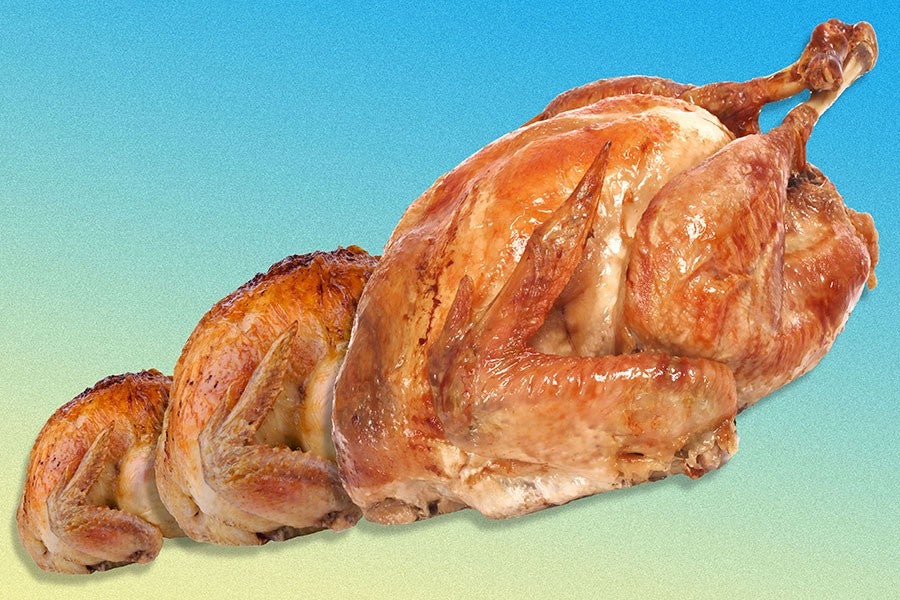In 2014, the word “turducken” entered the Merriam-Webster dictionary, becoming part of the “official” lexicon. But people from New Orleans — where the term was coined — weren’t bursting with local pride: Instead, they were asking, “What took so long?”
“The first time a triple-roast of deboned poultry was called a ‘Turducken’ was supposedly in 1985 at Hebert’s Meats in Maurice, Louisiana,” says food blogger and history professor H.D. Miller.
Considering the word was inaugurated with much newer ones like “dubstep” and “selfie,” it’s no wonder there were some hard feelings over this decades-old dish.
That said, the turducken’s legacy has expanded well beyond Louisiana. For years, John Madden would reference eating turduckens around Thanksgiving, leading to comic Frank Caliendo’s bird-obsessed Madden character on MADtv. It’s been all over TV in general, including Food Network shows and especially adult-friendly cartoons like Regular Show and Bob’s Burgers. Believe it or not, there was even a villain named Turducken on Teenage Mutant Ninja Turtles.
Despite our somewhat sick fascination with the ‘turducken,’ though, it’s just a word. The dish itself is actually a fairly rudimentary example of a centuries-old tradition known as “engastration,” i.e., stuffing one animal into another.
“People have been stuffing one animal inside of another, inside of another since at least the Romans, if not earlier,” says Miller, who contends that the turkey-duck-chicken combo cannot possibly be that new (long pre-dating even Herbert’s Meats). Given that the Romans had a recipe for a cow stuffed with a pig stuffed with a goose stuffed with a duck stuffed with a chicken, it stands to reason that somewhere along the line, turduckens were served for the occasions that didn’t quite call for a, um, copigooducken?
Another dish, listed in a French cookbook from 1807 — brought to our attention by Pride and Pudding author Regula Ysewijn — used 16 birds. Yet another “contained three geese, three turkeys, seven hares, twelve partridges, a ham and a leg of veal,” says Ysewijn. The famous 1747 English cookbook The Art of Cookery Made Plain and Easy has a dish that called for turkey, goose, fowl, partridge and pigeon. According to food historian Sam Bilton, another recipe in the same book called for a turkey/goose/chicken/pigeon combo. The book’s author, Hannah Glasse, refers to it as a “Yorkshire Christmas Pie,” though naturally, we prefer “turgookengeon.”
There is also a fermented dish known as “kiviak,” which is a traditional Inuit dish from Greenland in which a seal is stuffed with as many as 500 auks (a sort of penguin-like bird) and hidden under a pile of rocks for several months before consumption. (We do not recommend Googling images of “kiviak” — trust us on this one.)
But does this long history of animal stuffing mean that you should make a turducken or some other engastrated concoction this Thanksgiving? Well, it depends on what you’re going for. You see, in basically every case, these elaborate dishes were meant not for practical meals, but for special occasions, or a decadent meal for the rich.
“It’s stunt dining,” explains Miller, designed to be “outrageous, so that your guests are impressed with the trouble you’ve taken on their behalf.”
Though if you want a meal that actually tastes good, you may want to consider looking elsewhere.
The sad fact is that these nesting dolls of the culinary world tend to be a bit lackluster when it comes to the main event — i.e., eating them. First, they’re often overcooked, due to the fact that it takes a long time to cook each successive layer of critter. And according to food historian Julia Skinner, “It’s a pretty intense food — they taste pretty good, because all those birds [individually] taste good, but it’s very rich and have a lot of different poultry flavors going on. It’s definitely not something I’d want to eat much of.”
So, if you decide to make a turducken, a gooducken or even a copigooducken this Thanksgiving, what the hell, go for it. Your guests will certainly be thoroughly impressed — just don’t expect them to ask for seconds.

